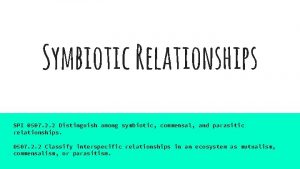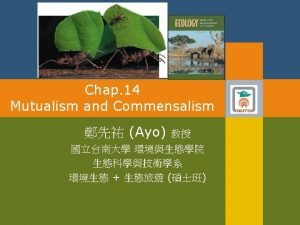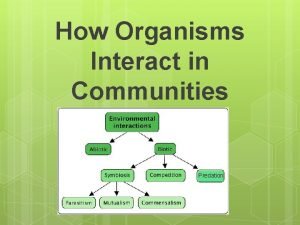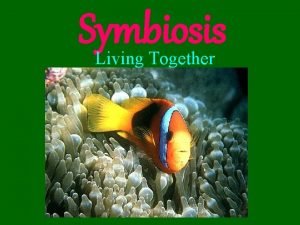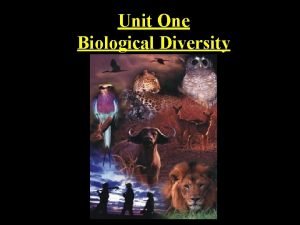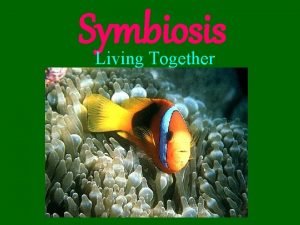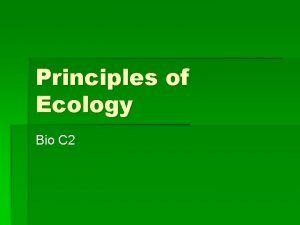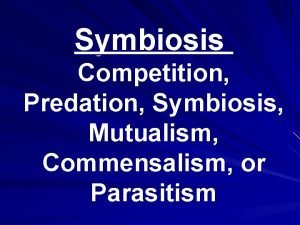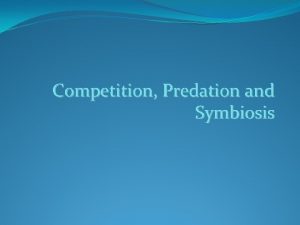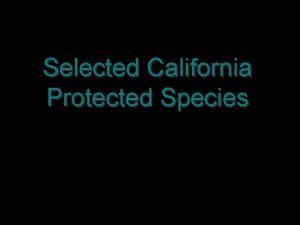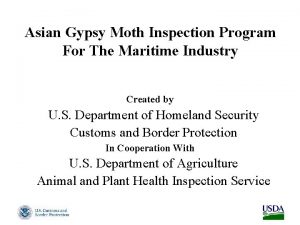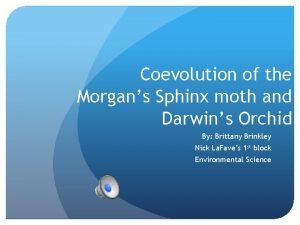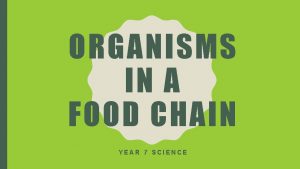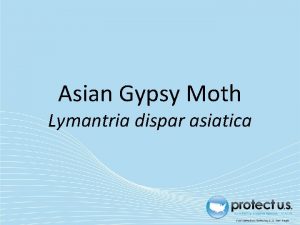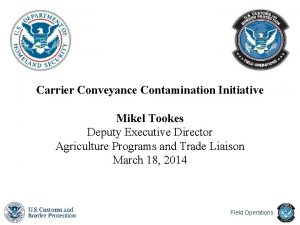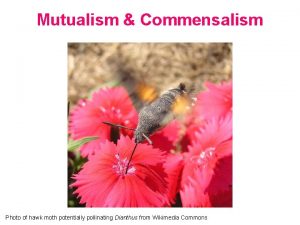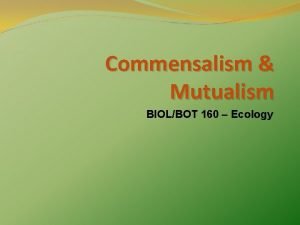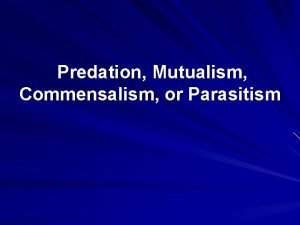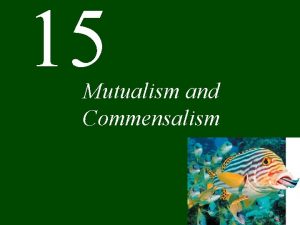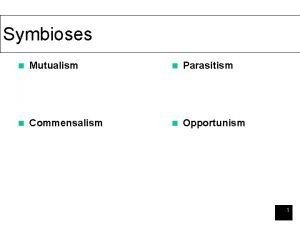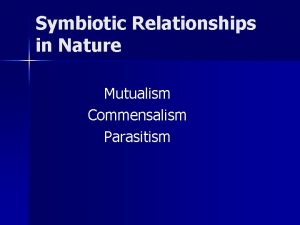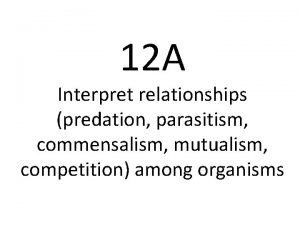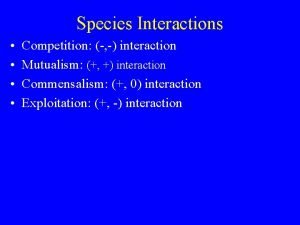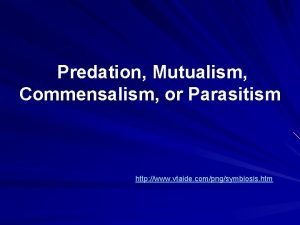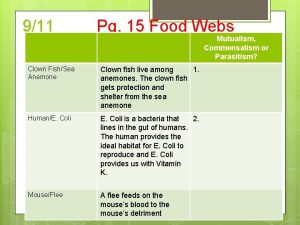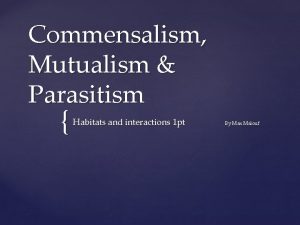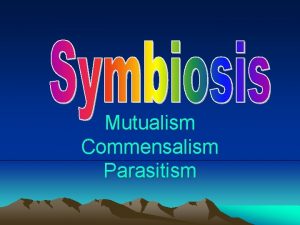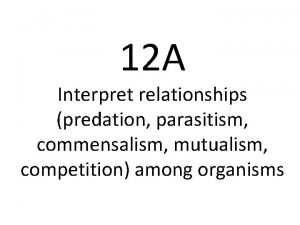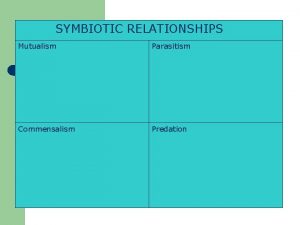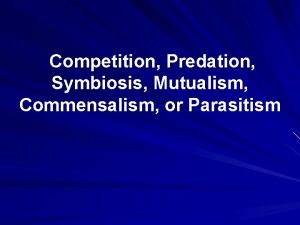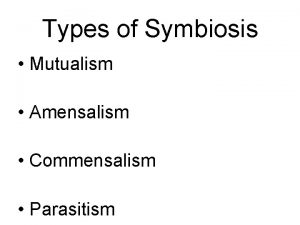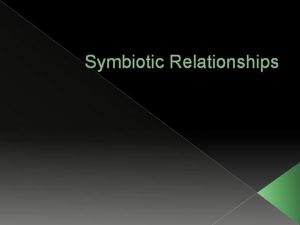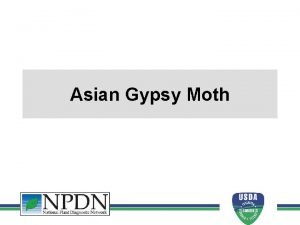Mutualism Commensalism Photo of hawk moth potentially pollinating






















- Slides: 22

Mutualism & Commensalism Photo of hawk moth potentially pollinating Dianthus from Wikimedia Commons

Positive Interactions Facilitation – in other words, “+” means benefits outweigh costs Commensalism = +/0 Mutualism = +/+ What might the benefits and costs be to each partner in a pollination mutualism? Photo of hawk moth potentially pollinating Dianthus from Wikimedia Commons

Obligate vs. Facultative Mutualisms Obligate – not optional, e. g. , fig - fig wasp Facultative – optional, e. g. , fig - seed disperser Fig & its pollinating fig wasps Fig & one of its many seed-dispersers (in this case a frugivorous bat) Photo of fig & fig wasps from http: //www. zoology. ubc. ca; photo of bat & figs from http: //www. sserc. org. uk/wwwroot 2/members/Photos/Plants/seed%20 dispersal/Menu. htm

Types of Benefits to Mutualists Service Mutualisms One partner receives an ecological service from the other – e. g. , pollination, seed dispersal, or defense against herbivores, predators, or parasites E. g. , ant - bullhorn acacia symbiosis Photo from Wikimedia Commons

Types of Benefits to Mutualists Habitat Mutualisms One partner obtains shelter, a place to live, or favorable habitat from the other E. g. , alpheid shrimp - goby symbiosis Photo from Wikimedia Commons

Types of Benefits to Mutualists Trophic Mutualisms One partner receives energy or nutrients from its partner E. g. , mychorrizae – plant root - fungus symbiosis (this type of mutualism probably characterized the very first land plants ~500 mya) Photomicrograph from Wikimedia Commons

Types of Benefits to Mutualists Trophic Mutualisms One partner receives energy or nutrients from its partner E. g. , E. coli is part of the human microbiome Humans require various essential organic compounds that the organism itself cannot synthesize, including various: purines & pyrimidines amino acids vitamins Photomicrograph from Wikimedia Commons

Mutualists Are Not Altruists Each mutualistic partner seeks to gain net benefit from the other (just like a parasite seeks to gain net benefit from a host); this can create conflicts Yuccas selectively abort flowers into which too many eggs are laid Photo of yucca moth from: http: //www. cals. ncsu. edu/course/ent 425/images/pollinators_gallery/pages/06_yucca_moth_jpg. htm; Harms’s photo of yuccas in White Sands Nat’l. Park, NM; Bowman, Hacker & Cain (2017), Fig. 15 after Pellmyr & Huth (1994) Nature

Cheaters can be Penalized or Sanctioned Split-plate design: (A) plant roots labeled with 14 C; (B) mycorrhizal fungus without P; (C) mycorrhizal fungus with P (either 35 M or 700 M) Plant can penalize fungus (for poor P delivery) with low C delivery A B Kiers et al. (2011) Science C

Cheaters can be Penalized or Sanctioned Split-plate design: (A) plant roots labeled with 14 C; (B) mycorrhizal fungus without P; (C) mycorrhizal fungus with P (either 35 M or 700 M) Title of the project: Plant can penalize fungus (for poor P delivery) with low C delivery A B Fungus can penalize plant (for poor C delivery) with low P delivery C Split-plate design: (A) fungal hyphae labeled with 33 P; (B) roots with no access to sucrose; (C) roots with access to sucrose (either 5 m. M or 25 m. M) Kiers et al. (2011) Science “Reciprocal rewards stabilize cooperation in the mycorrhizal symbiosis”

Mutualisms Can Evolve From Other Types of Species Interactions The heart-warming tale of a reformed parasite Notorious filamentous fungal pathogen, Colletotrichum magna, causes anthracnose disease in cucurbits Member of a large clade of pathogens capable of infecting the majority of agricultural crops worldwide Infection occurs when spores adhere to host tissue, enter a cell, and subsequently grow through the host leaving a trail of necrotic tissue Original research from Freeman & Rodriguez (1993) Science; photo of anthracnose on cucumber leaf from http: //urbanext. illinois. edu/hortanswers/detailproblem. cfm? Pathogen. ID=128

Mutualisms Can Evolve From Other Types of Species Interactions The heart-warming tale of a reformed parasite “Path-1” = single-locus mutant of C. magna that spreads throughout the host (albeit more slowly) without necrosis & is a non-sporulating endophyte Plants infected with Path-1 were protected from the wild-type & were immune to an unrelated pathogenic fungus, Fusarium oxysporum Path-1 may induce host defenses against pathogens or may outcompete other fungi Considerable potential exists to tailor endophytes as biocontrol agents; an example of Darwinian Agriculture Original research from Freeman & Rodriguez (1993) Science; photo of cucurbits grown without (left) and with (right) Path-1 C. magna, both in the presence of Fusarium, from http: //wfrc. usgs. gov/research/contaminants/STRodriguez 4. htm

Species Interactions Can Vary Geographically, Temporally, or in Other Context-Dependent Ways Cattail facilitated smallflowered forget-me-not at low soil temp. (possibly owing to soil aeration) Photo of cattail from Wikimedia Commons; Bowman, Hacker & Cain (2017), Fig. 15. 8, after Callaway & King (1996) Ecology

Species Interactions Can Vary Geographically, Temporally, or in Other Context-Dependent Ways Cattail facilitated smallflowered forget-me-not at low soil temp. (possibly owing to soil aeration) Cattail competed with smallflowered forget-me-not at high soil temp. Photo of cattail from Wikimedia Commons; Bowman, Hacker & Cain (2017), Fig. 15. 8, after Callaway & King (1996) Ecology

*When is it Coevolution? Reciprocal adaptive evolution in each of 2 interacting species in response to adaptations in the other species Daniel H. Janzen e. g. , ant-acacia mutualism “Darwin’s hawk moth” potentially pollinating its Malagasy orchid Photo of Janzen from http: //www. fbbva. es/TLFU/tlfu/ing/microsites/ premios/fronteras/galardonados/2011/ecologia. jsp; image of “Darwin’s hawk moth” pollinating its Malagasy orchid from http: //botany. si. edu/events/sbsarchives/sbs 2008; *original idea from Janzen (1980) Evolution

Positive interactions can influence individuals, populations, interactions between species, communities & ecosystems Zoxanthellae = unicellular algal protist symbionts with corals; algae receive N, corals receive carbohydrates A world without zoxanthellae would be a world without most shallow-water corals Imagine a world without corals! Photomicrograph from Wikimedia Commons

Mutualism does not occur in isolation from other species interactions E. g. , “Aprovechados” (parasites of mutualisms) sensu Mainero & Martinez del Rio 1985 Parasitic fig wasp Photo from http: //www. pbs. org/wnet/nature/episodes/the-queen-of-trees/photo-essay-an-extraordinaryecosystem/1356/attachment/gal 23/

Mutualism does not occur in isolation from other species interactions E. g. , Interactions among mutualists of semi-independent function E. g. , Ants that act as defense mutualists against herbivores may influence pollinators’ activities & pollination success (see: Wagner 2000; Willmer & Stone 1997) Photo from http: //coronadetucson. blogspot. com/2009_03_01_archive. html

Indirect Mutualisms “The enemy of my enemy is my friend” (e. g. , plants whose defenses enlist the services of the “third trophic level”) 3 - + + 2 - Me + +

Indirect Mutualisms Cartoon and examples from Degenhardt (2009)

Indirect Mutualisms “The friend of my friend may be my friend too” (e. g. , a seed-disperser may be an indirect mutualist of a pollinator of the same plant) Me +/+ + 2 + + + 1

Indirect Mutualisms +/+ + + K. Harms’s photo of strangler fig, Queensland, Australia; photo of fig & fig wasps from http: //www. zoology. ubc. ca; photo of bat & figs from http: //www. sserc. org. uk/wwwroot 2/members/Photos/Plants/seed%20 dispersal/Menu. htm
 Difference between commensalism and mutualism
Difference between commensalism and mutualism Mutualism vs commensalism
Mutualism vs commensalism Parasitism mutualism and commensalism
Parasitism mutualism and commensalism Parasitism commensalism and mutualism are examples of
Parasitism commensalism and mutualism are examples of Commensalism and mutualism difference
Commensalism and mutualism difference Forms of symbiotic relationships
Forms of symbiotic relationships Commensalism and mutualism
Commensalism and mutualism Mutualism vs commensalism
Mutualism vs commensalism Parasitism
Parasitism Section 11–1 the work of gregor mendel
Section 11–1 the work of gregor mendel Pollinating agents example
Pollinating agents example Potentially shippable product increment
Potentially shippable product increment Potentially renewable resources examples
Potentially renewable resources examples Keeping food safe chapter 1
Keeping food safe chapter 1 California sphinx moth
California sphinx moth Asian gypsy moth inspection
Asian gypsy moth inspection Morgan sphinx moth
Morgan sphinx moth Ethereal moth wikipedia
Ethereal moth wikipedia Gypsy moth population
Gypsy moth population Moth food chain
Moth food chain Moth
Moth Gypsy moth caterpillar
Gypsy moth caterpillar Asian gypsy moth vessel inspection
Asian gypsy moth vessel inspection
